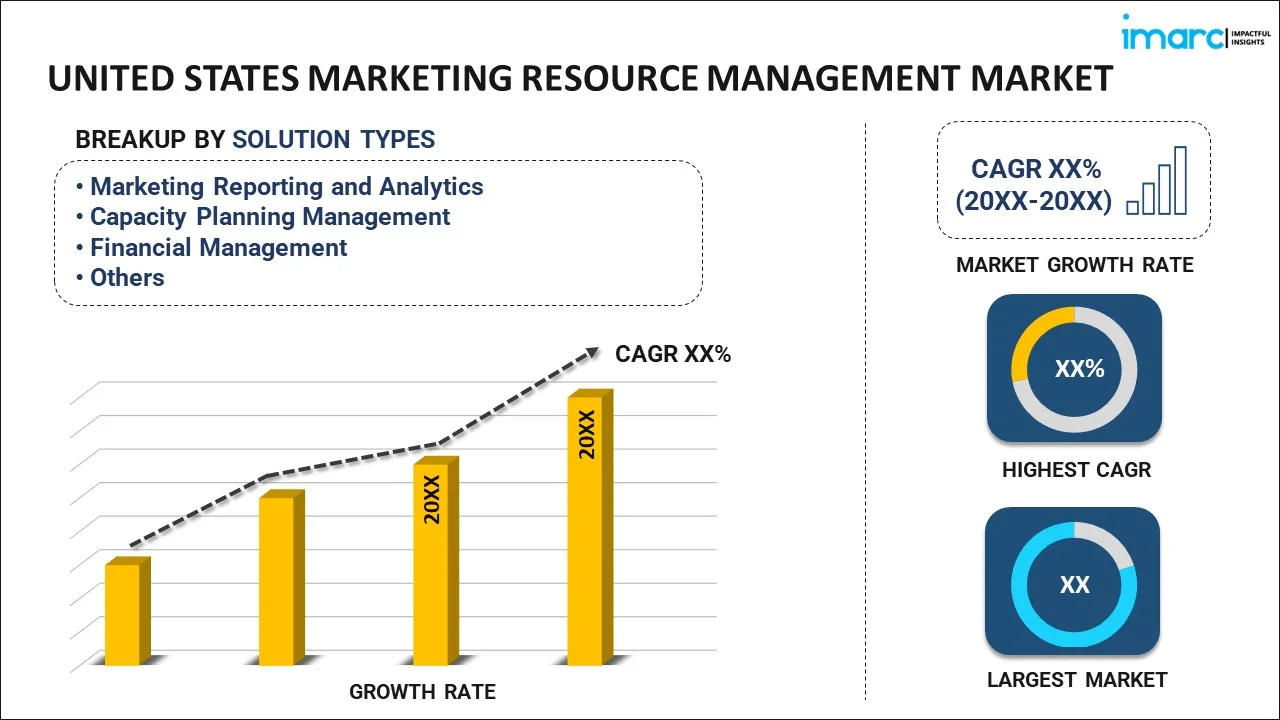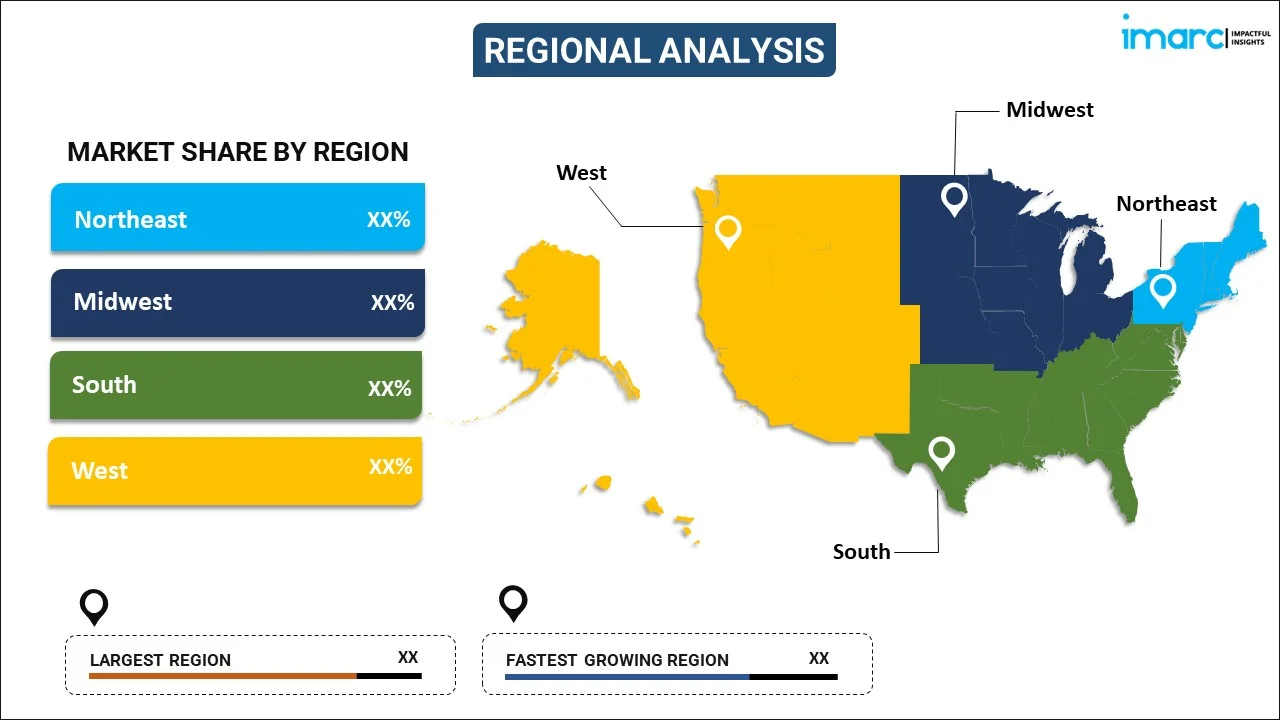
United States Marketing Resource Management Market Report by Solution Type (Marketing Reporting and Analytics, Capacity Planning Management, Financial Management, Creative Production Management, Brand and Advertising Management, Marketing Asset Management, and Others), Deployment Type (On-premises, Cloud-based), Enterprise Size (Large Enterprises, Small and Medium-sized Enterprises), Industry Vertical (Media and Entertainment, Retail, BFSI, Healthcare, Consumer Goods, Automotive, Manufacturing, Apparel, and Others), and Region 2025-2033
Market Overview:
United States marketing resource management market size reached USD 1.0 Billion in 2024. Looking forward, IMARC Group expects the market to reach USD 2.5 Billion by 2033, exhibiting a growth rate (CAGR) of 10.7% during 2025-2033. The increasing demand for cloud services and big data analytics, the rising need for more reliable and scalable data processing and storage facilities and stringent regulatory compliance represent some of the key factors driving the market.
|
Report Attribute
|
Key Statistics
|
|---|---|
|
Base Year
|
2024 |
|
Forecast Years
|
2025-2033
|
|
Historical Years
|
2019-2024
|
| Market Size in 2024 | USD 1.0 Billion |
| Market Forecast in 2033 | USD 2.5 Billion |
| Market Growth Rate (2025-2033) | 10.7% |
United States Marketing Resource Management Market Analysis:
- Key Market Drivers: Mismatches between marketing operations and return on investment (ROI) are necessitating adoption of MRM solutions. Organizations are seeking centralized resource, budget, and campaign management to enhance efficiency, consistency, and performance of distributed marketing teams.
- Key Market Trends: According to United States marketing resource management market trends, maturity of AI-powered automation, real-time analytics, and cloud-based deployments is revolutionizing MRM platforms. Enterprises are emphasizing personalized customer engagement and integrated marketing workflows to improve collaboration, responsiveness, and cross-channel marketing effectiveness.
- Competitive Landscape: The marketplace consists of a rich combination of enterprise-class and niche vendors that provide configurable MRM solutions. User experience innovation, data integration features, and modular toolsets are critical differentiators that influence vendor positioning in a rapidly maturing market
- Challenges and Opportunities: Although integration complexity and data security continue to be issues, increasing digital transformation initiatives hold great growth opportunity. MRM providers have opportunities to aid hybrid teams, improve analytics, and grow within mid-sized companies that need nimble marketing infrastructure.
Marketing resource management (MRM) is a cloud-based software application adopted by organizations to efficiently centralize and manage their marketing operations. This tool facilitates the organization in consolidating brand compliance, streamlining marketing workflows, and monitoring return on investment (ROI). Its core functions encompass budgeting, planning, and the comprehensive management of marketing assets, content, and projects. Moreover, it plays a pivotal role in evaluating the effectiveness of marketing communications and initiatives. In line with this, due to these advantageous features, marketing resource management sees widespread utilization across diverse industries, including but not limited to banking, financial services, insurance (BFSI), information technology (IT), healthcare, retail, and automotive sectors. Consequently, it is gaining extensive traction across the United States.
United States Marketing Resource Management Market Trends:
Artificial Intelligence and Automation Tool Integration in MRM Platforms
Amplified integration of artificial intelligence (AI) and automation tools within marketing resource management (MRM) platforms is a strong trend influencing the United States market. Contemporary businesses are looking to automate their marketing processes, maximize resource utilization, and improve campaign effectiveness. AI-powered features like predictive analytics, sentiment analysis, and smart content suggestions are fast becoming standard in MRM systems. These applications help marketing groups make data-driven decisions while minimizing manual effort. Automation functionality also enhances time-to-market by streamlining task management, approval processes, and content publishing. As companies continue to expand their digital businesses, MRM platforms are likely to develop with more extensive AI integration to enable personalization, audience segmentation, and performance measurement. This shift would likely go a long way in adding up to the United States marketing resource management market growth, consolidating the necessity for scalable and intelligent marketing infrastructure in competitive digital environments.
Centralization and Collaborative Marketing Ecosystems
There is rising prominence in developing centralized and collaborative marketing ecosystems within the purview of Marketing Resource Management in the United States. Organizations are now looking for solutions that allow effortless coordination among cross-functional marketing teams, creative agencies, and other stakeholders. With the use of centralized platforms, companies are able to ensure consistency of brand messaging, effectively manage digital assets, and process campaign delivery in multiple channels. This trend is also driven by the increasing need for transparency and accountability in marketing processes. Centralized ecosystems are going to reduce redundancy and enhance visibility into performance metrics, budgets, and timelines. With more and more companies adopting hybrid and remote working models, collaboration tools and document sharing in real-time become all the more relevant. All these factors are expected to fuel the United States marketing resource management market share as the companies move towards unified solutions that facilitate efficient and collaborative marketing management in support of data integration from different touch points.
Growth of Cloud-Based MRM Implementations in Multiple Industries
Cloud-based marketing resource management implementations are growing fast across industries in the United States, providing flexibility, scalability, and lower infrastructure expenses. Companies are increasingly moving away from on-premises systems to cloud-native platforms for supporting decentralized teams, facilitating quicker updates, and safe data access from various points. This shift reflects the increasing demand for subscription-based software-as-a-service (SaaS) models, which enable companies to extend their MRM capacity according to changing requirements. Cloud solutions further enable integrations with other marketing technologies like customer relationship management (CRM), digital asset management (DAM), and analytics tools. As retail, healthcare, and financial services sectors grow their digital marketing activities, cloud MRM platforms are set to facilitate nimble campaign management and compliance monitoring. This trend is exemplified in the United States marketing resource management market analysis, with cloud adoption remaining poised to redefine operational effectiveness and real-time collaboration in contemporary marketing landscapes.
United States Marketing Resource Management Market Segmentation:
IMARC Group provides an analysis of the key trends in each segment of the market, along with forecasts at the country level for 2025-2033. Our report has categorized the market based on solution type, deployment type, enterprise size, and industry vertical.
Solution Type Insights:

To get more information on this market, Request Sample
- Marketing Reporting and Analytics
- Capacity Planning Management
- Financial Management
- Creative Production Management
- Brand and Advertising Management
- Marketing Asset Management
- Others
The report has provided a detailed breakup and analysis of the market based on the solution type. This includes marketing reporting and analytics, capacity planning management, financial management, creative production management, brand and advertising management, marketing asset management, and others.
Deployment Type Insights:
- On-premises
- Cloud-based
A detailed breakup and analysis of the market based on the deployment type have also been provided in the report. This includes on-premises and cloud-based.
Enterprise Size Insights:
- Large Enterprises
- Small and Medium-sized Enterprises
The report has provided a detailed breakup and analysis of the market based on the enterprise size. This includes large enterprises and small and medium-sized enterprises.
Industry Vertical Insights:
- Media and Entertainment
- Retail
- BFSI
- Healthcare
- Consumer Goods
- Automotive
- Manufacturing
- Apparel
- Others
A detailed breakup and analysis of the market based on the industry vertical have also been provided in the report. This includes media and entertainment, retail, BFSI, healthcare, consumer goods, automotive, manufacturing, apparel, and others.
Regional Insights:

- Northeast
- Midwest
- South
- West
The report has also provided a comprehensive analysis of all the major regional markets, which include Northeast, Midwest, South, and West.
Competitive Landscape:
The market research report has also provided a comprehensive analysis of the competitive landscape. Competitive analysis such as market structure, key player positioning, top winning strategies, competitive dashboard, and company evaluation quadrant has been covered in the report. Also, detailed profiles of all major companies have been provided.
Latest News and Developments:
- In July 2025, Omneky launched Smart Ads, an AI-based feature aimed at automating the creation of high-quality, on-brand ads. With brand assets and data integrated, Smart Ads simplifies campaign processes, increases creative consistency on platforms, and allows marketers to scale personalized content effectively for better performance and engagement.
United States Marketing Resource Management Market Report Coverage:
| Report Features | Details |
|---|---|
| Base Year of the Analysis | 2024 |
| Historical Period | 2019-2024 |
| Forecast Period | 2025-2033 |
| Units | Billion USD |
| Scope of the Report | Exploration of Historical and Forecast Trends, Industry Catalysts and Challenges, Segment-Wise Historical and Predictive Market Assessment:
|
| Solution Types Covered | Marketing Reporting and Analytics, Capacity Planning Management, Financial Management, Creative Production Management, Brand and Advertising Management, Marketing Asset Management, Others |
| Deployment Types Covered | On-premises, Cloud-based |
| Enterprise Sizes Covered | Large Enterprises, Small and Medium-sized Enterprises |
| Industry Verticals Covered | Media and Entertainment, Retail, BFSI, Healthcare, Consumer Goods, Automotive, Manufacturing, Apparel, Others |
| Regions Covered | Northeast, Midwest, South, West |
| Customization Scope | 10% Free Customization |
| Post-Sale Analyst Support | 10-12 Weeks |
| Delivery Format | PDF and Excel through Email (We can also provide the editable version of the report in PPT/Word format on special request) |
Key Benefits for Stakeholders:
- IMARC’s industry report offers a comprehensive quantitative analysis of various market segments, historical and current market trends, market forecasts, and dynamics of the United States marketing resource management market from 2019-2033.
- The research report provides the latest information on the market drivers, challenges, and opportunities in the United States marketing resource management market.
- Porter's five forces analysis assist stakeholders in assessing the impact of new entrants, competitive rivalry, supplier organization, buyer organization, and the threat of substitution. It helps stakeholders to analyze the level of competition within the United States marketing resource management industry and its attractiveness.
- Competitive landscape allows stakeholders to understand their competitive environment and provides an insight into the current positions of key players in the market.
Key Questions Answered in This Report
The marketing resource management market in the United States was valued at USD 1.0 Billion in 2024.
The United States marketing resource management market is projected to exhibit a (CAGR) of 10.7% during 2025-2033, reaching a value of USD 2.5 Billion by 2033.
Key drivers of the United States marketing resource management market are the increasing demand for centralized marketing, greater use of digital marketing applications, and requirements for enhanced budget and asset management. Also influencing the adoption of MRM solutions is the increasing use of data-driven decision-making, real-time team collaboration, and the move towards cloud-based platforms.
Need more help?
- Speak to our experienced analysts for insights on the current market scenarios.
- Include additional segments and countries to customize the report as per your requirement.
- Gain an unparalleled competitive advantage in your domain by understanding how to utilize the report and positively impacting your operations and revenue.
- For further assistance, please connect with our analysts.
 Request Customization
Request Customization
 Speak to an Analyst
Speak to an Analyst
 Request Brochure
Request Brochure
 Inquire Before Buying
Inquire Before Buying




.webp)




.webp)












